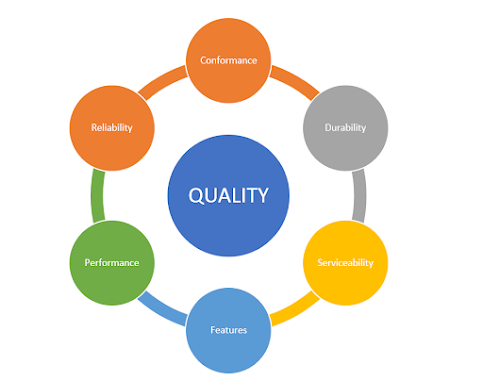DIMENSIONS OF QUALITY
The project firms previously agreed that higher
quality increased project expenses. However, they are now aware that higher
quality increases business volumes. Tasks' increasing complexity and size have
forced businesses to put more emphasis on quality at every level. What other In
any other case, the cumulative effect of every flaw in the several stages will
cause a notable decline in the ultimate result's quality. Quality is relative,
and different people define it differently.
Performance, features, dependability, conformity,
solidness, serviceability, style, and perceived quality are the eight
fundamental components or categories of quality that Garvin suggests can serve
as a framework for critical evaluation.
1. Performance
Performance alludes to a thing's fundamental
functional characteristics. Performance for an automobile would include
features like acceleration, handling, cruising speed, and comfort.
2. Features
Features are typically the "extravagant
accessories" of goods and services, those qualities that add to their
basic functionality. They are the auxiliary components of performance.
This characteristic reflects the risk of an object
breaking. down or bombing within a set amount of time.
4. Conformity
Conformance refers to how closely an item's design
and functional characteristics adhere to established standards. The two most
common causes of nonconformance are processing plant error rates and the
frequency of customer calls for assistance when an item is in their possession.
5. Durability
Solidity is a feature of an item's life that involves
both economic and technical considerations. In actuality, the amount of use
that can be gotten out of a thing before it degrades can be described as its
toughness.
Serviceability is the ability to solve anything
quickly, courteously, and simply. An organization's complaint handling
procedures are also likely to have an impact on customers' opinions in cases
where problems are not immediately resolved and complaints are documented. A
thorough evaluation of the item and administration quality.
7. Aesthetics
7. Aesthetics An impression of a person's tendency
and personal judgement are included when describing how something seems, feels,
sounds, tastes, or smells. It may be difficult to satisfy everyone on this
aspect of quality.
8. Perceived Quality
Customers may be considering brands because of
indirect measures rather than comprehensive information about an item's or
administration's credits.
We may conclude from the discussion above that quality is an issue that is somewhat important in the management world. Regarding the quality of a product or service, the operation manager must be highly detailed. The quality requirements can be met using a variety of approaches. Project quality control includes all the procedures necessary to fulfil the demands of its stakeholders. A quality plan must be created, shared with the team, and properly implemented, according to the operation manager.

Comments
Post a Comment